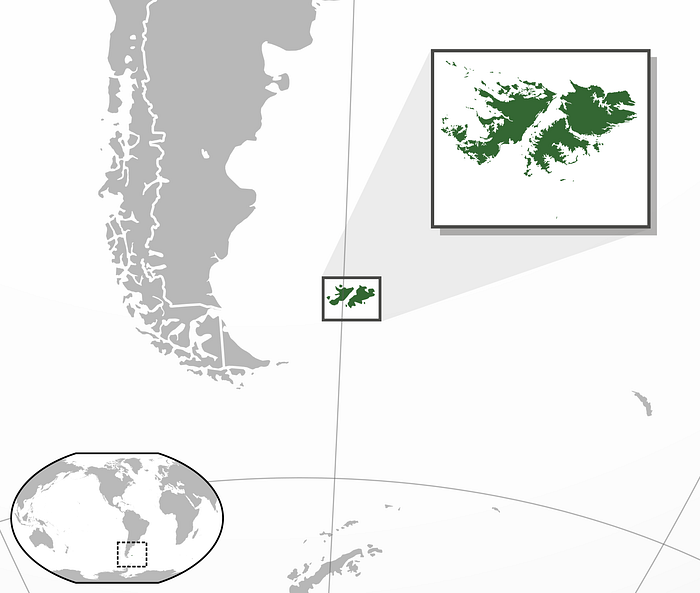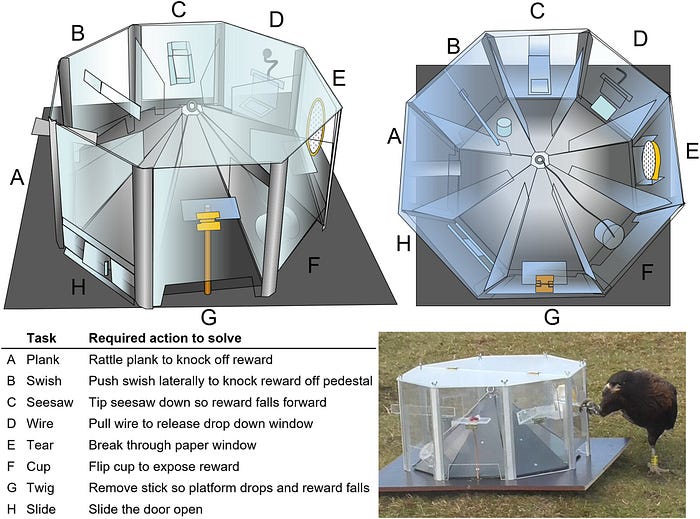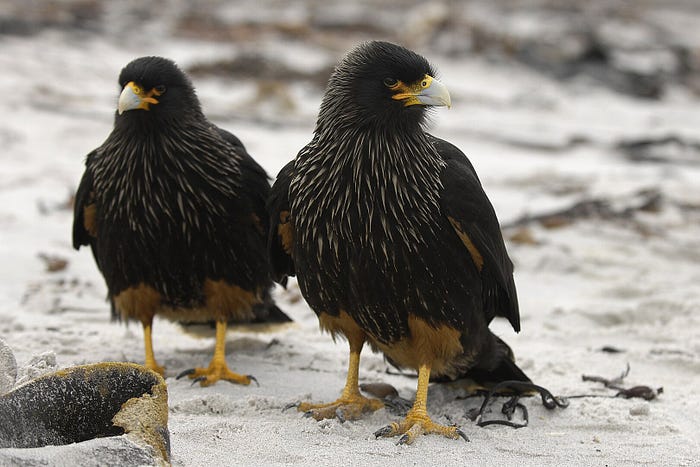A recent study in falcons highlights commonalities in ecology that underlie the evolution of innovative thinking in both corvids and cockatoos
© by GrrlScientist for Forbes | LinkTr.ee
A team of cognitive scientists whose work I've followed and shared with you for a number of years reports that a species of falcon can solve puzzles to gain a food reward as well as — or maybe better — than can Goffin's cockatoos, who are these researchers' typical study subjects. The scientists, who are with the University of Veterinary Medicine in Vienna, collaborated with a colleague at the Instituto de Investigaciones Marinas y Costeras, to test the cognitive abilities of wild striated caracara, Phalcoboenus australis, a handsome blackish falcon that lives exclusively on the Falklands Islands (Islas Malvinas), a rugged and remote archipelago located at the southern tip of South America and Tierra del Fuego (Figure 1).

Known locally as Johnny rooks, these mischievous, playful and often destructive falcons excel at problem-solving, acting rather like keas, a highly intelligent alpine parrot that lives in the mountains of New Zealand. The striking similarities in behaviors between the two species made the scientists wonder whether striated caracaras might be capable of solving puzzle boxes to obtain a food reward as Goffin's cockatoos can do.
"I kind of had a hunch that there is something special about these birds," said the study's lead author, cognitive behavioral ecologist Katie Harrington, a doctoral student at University of Veterinary Medicine in Vienna.
Puzzle boxes are one tool used to assess problem-solving abilities and intelligence in several types of birds and other animals. For these experiments, the boxes were modified to test falcons with talons and sharp beaks, and baited with a piece of raw red meat. Each box held eight different puzzles requiring specific skills to solve them, including pulling a door sideways, pushing a lever and tearing through a piece of paper (Figure 2).

The puzzle boxes were placed out into the open where the wild falcons were sure to see them and, hopefully, investigate. And investigate, they did! Within minutes, the wild striated caracaras noticed and began inspecting the puzzle boxes. The researchers watched the falcons as they systematically worked out how to solve the puzzles, using either their beaks or their feet, without any prior training, to gain the food reward.
"We were really blown away by how quickly they set to the tasks and solved them," Ms Harrington said in a statement. "This is unlike anything we've seen before in wild birds of prey."
Of the 15 falcons that discovered the puzzle box and attempted to solve the puzzles, all of them succeeded in solving at least one puzzle and ten of them solved all of them — often more quickly than the Goffin's cockatoos had done. Interestingly, some of the falcons solved some puzzles that Goffin's cockatoos were unable to solve.
Ms Harrington and collaborators allowed as many of the wild falcons as possible to solve the puzzles under natural conditions, and each bird — one at a time — only had one chance per day, which allowed the researchers to monitor each individual falcon's progress.
"The caracaras were so eager to solve the puzzles that some even started running toward the box as soon as we set it on the ground," Ms Harrington reported. "They'd then energetically kick and pull at different functional parts the same way we would grab something to learn how it works. They'd also move to look at the box from different angles, crouching down to look from below or jumping on top to look from above."
Why are these falcons so clever and so boldly exploratory? According to the researchers, their environment probably played a strong role in this.
"Striated caracaras have to be really exploratory, constantly examining new situations in their environment to find out what works for them," Ms Harrington explained. "Is this food? What can I do with this? It takes a certain creative bravery to make life work on the Falklands."
After conducting a detailed analysis of the caracaras' performance and comparing it with that of Goffin's cockatoos, Ms Harrington and collaborators found this species of falcon is as cognitively formidable as cockatoos.
"There were some tasks the caracaras were even better at, most likely due to differences in their ecology," explained the study's senior co-author, Megan Lambert, a postdoctoral fellow at the University of Veterinary Medicine, Vienna. Dr Lambert specializes in studying and comparing parrot and corvid cognition.
"Much of what we know about avian intelligence comes from parrots and corvids," Dr Lambert replied. "These caracaras face a lot of the same pressures and offer a really great opportunity to study cognition in the wild."
The findings extend our knowledge of the environmental conditions that may be necessary for the evolution of problem-solving abilities in animals in general. In birds, inhabiting a variable environment with unpredictable resources appears to encourage the mental flexibility necessary to find potentially beneficial solutions to new problems.
Source:
Katie J. Harrington, Remco Folkertsma, Alice M.I. Auersperg, Laura Biondi and Megan L. Lambert (2023). Innovative problem solving by wild falcons, Current Biology | doi:10.1016/j.cub.2023.10.061
Socials: Bluesky | CounterSocial | LinkedIn | Mastodon | MeWe | Post.News | Spoutible | SubStack | Tribel | Tumblr | Twitter
Originally published at Forbes.com on 11 December 2023.

